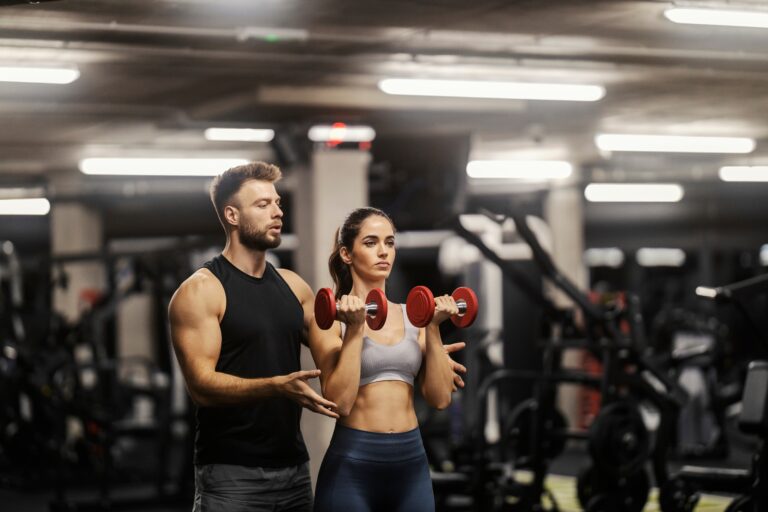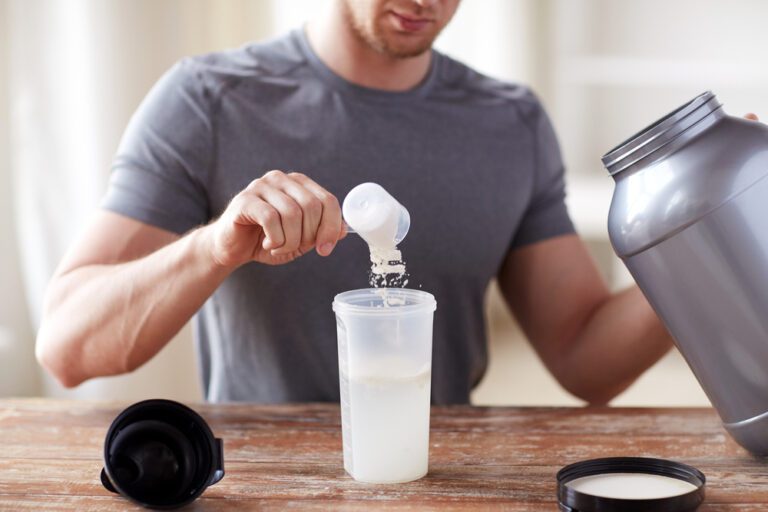One of the biggest fitness myths is that you need high-tech, fancy equipment to build serious muscle. Can modern machines and a well-equipped gym enhance your overall experience?
Absolutely. But let’s not forget that free weights have stood the test of time for a reason, they work.
Just think about the “old-school era” of bodybuilding. Legends like Arnold Schwarzenegger and Lou Ferrigno didn’t have many of the fancy weight machines we have access to today. Yet, they built iconic physiques using basic tools like dumbbells and barbells.
Their secret? Intensity, focus, and making the most of what they had. That said, if you’re lucky enough to have access to both free weights and machines, there’s no reason not to take advantage of both.
Today, we will talk about the difference between free weights and weight machines and break down the pros and cons of each so you can decide for yourself which is the best method for your hypertrophy goals.
Free Weights vs Weight Machines: What’s the Difference?
Free weights and weight machines serve the same ultimate purpose, helping you build strength and muscle, but they work in a few fundamentally different ways.
Free Weights
When we say free weights, think dumbbells, barbells, and kettlebells. Plates, ankle weights, and medicine balls are also considered free weights.
Free weights are great for building muscle because they allow for a full range of motion. They can also recruit stabilizing muscles because you control the weight entirely. There isn’t a machine helping you out. This can translate to functional strength, better balance, and improved coordination, which are especially useful outside the gym.
For the average person, free weights offer many of the same benefits as machines, plus some. Because you have to stabilize and balance the weight yourself, you’ll activate a host of smaller, often-overlooked muscles. That means you can actually get more “bang for your buck” with each exercise, engaging more of your muscles. That said, free weights are a bit less forgiving than machines, and for beginners, that can feel intimidating. But with practice (or guidance from a trainer), free weights are just as good as machines for muscle-building.
When it comes to using free weights, you’ll typically reach for dumbbells, barbells, or kettlebells to perform your exercises. Depending on the movement, you may need a pair of dumbbells or kettlebells.
However, it’s crucial to master your form for each exercise; starting lighter than you think is always wise to really nail down your technique and avoid unnecessary injuries. Mastering proper technique will not only keep you safe but also help you get the most from your training.
Weight Machines
A weight machine is any piece of equipment that guides you through a fixed range of motion. There are dozens… but think leg extension, leg curl, and tricep press. Cable systems are also considered weight machines.
Weight machines are great for all fitness levels, especially beginners or anyone recovering from an injury. Their fixed range of motion reduces the risk of using incorrect form. They also allow you to isolate specific muscles more easily, making them great for targeting weak spots.
You’ll typically be able to lift more weight on a machine than you could with free weights for the same exercise, thanks to the additional support and guided movement. This makes them a solid option if you want to push certain muscle groups without worrying about losing balance.
However, because the motion is guided, weight machines don’t engage as many stabilizing muscles as free weights. This limitation can impact the development of functional strength, which is important for activities that require balance and coordination. Machines may also feel restrictive if you’re trying to mimic natural, real-life movements.
Modern gyms offer an almost overwhelming variety of weight machines. For instance, there might be three different types of glute machines, numerous shoulder and chest press variations, and an entire room filled with leg machines.
While some of these machines are designed to target specific parts of a muscle, for example, seated leg curls emphasize the hamstrings while leg extensions focus on the quadriceps, many serve a similar purpose. Gyms often stock multiple options because personal preference plays a significant role. Some people find one machine’s mechanics or setup more comfortable than another’s.
Pros and Cons of Free Weights
Free weights are often seen as the gold standard for building muscle and improving functional strength. They offer a level of versatility that machines can’t quite match, allowing you to incorporate a wide range of exercises that mimic real-life movement patterns.
However, with this freedom comes responsibility, free weights demand more control and attention to form. Here are some of the advantages and challenges that come with free weight training.
Pros of Free Weights
Mimic Natural Movements
Free weights let you move the way your body naturally does, which is essential for building functional muscle. By mimicking natural movements, you engage multiple muscle groups and improve coordination. This leads to more balanced strength and better overall muscle development.
Engage Stabilizer Muscles
Stabilizer muscles are the smaller muscles that support and balance your body during movement. Free weights activate these muscles, creating a more dynamic workout. This leads to overall muscle engagement, which can enhance muscle growth by recruiting additional fibers and creating a stronger foundation for heavier lifts. As a result, you can build strength, balance, and coordination simultaneously. For this reason, some athletes prefer free weight training over machines.
Can Be Used For A Wide Range Of Exercises
Dumbbells, barbells, and kettlebells can be used for countless exercises targeting every muscle group. From squats to presses, rows, and weighted lunges, there isn’t a muscle group you can’t hit with free weights. For the average person, free weights offer many of the same benefits as machines, plus a few extras.
Promote Better Balance and Coordination
Since you’re in control of the movement, free weights help improve balance and coordination over time, which can reduce the risk of injury in both the gym and daily life.
Adaptable to All Fitness Levels
Whether you’re a beginner or a professional athlete, free weights can advance with you. You can start light and gradually increase the weight as you progress.
Inexpensive and Space-Saving
Compared to weight machines, free weights are more affordable and take up less space. They’re ideal for home gyms or anyone looking to train on a budget. Plus, if home workouts are your jam right now, free weights are more accessible and versatile than machines. Whether you’re setting up your garage, a corner of your living room, or squeezing in a quick session in a hotel gym, free weights let you keep your routine going without much fuss.
Accessible Almost Anywhere
You’ll be hard-pressed not to find free weights in just about any gym, even tiny hotel gyms. This makes them a reliable choice for travelers and anyone who likes to keep their exercise options flexible.
Important Considerations for Free Weights
The Importance of Slow, Controlled Movements
When working with free weights, moving slowly and with control isn’t just a suggestion, it’s essential for effective, safe training. Quick, jerky motions rely on momentum rather than muscle engagement, reducing the effectiveness of your workout. In contrast, performing each repetition deliberately helps you truly connect with the muscles you’re targeting, known as the “mind-muscle connection.”
This approach not only ensures the right muscles are doing the work but also decreases the risk of injury. You’ll be less likely to use improper form or let weights drift into awkward positions. Think of it like carefully steering a car through a tight turn, you want precision, not speed, to avoid disaster. By slowing things down, you give your stabilizers and larger muscle groups time to fire together, which builds strength you can trust both in and out of the gym.
Choosing Lighter Weights: When to Play It Safe
If you’re new to an exercise, still perfecting your form, or simply unsure about your current strength, it’s wise to start with lighter weights. Unlike machines, free weights don’t give you built-in support or “training wheels” if you bite off more than you can chew.
Stick to manageable loads until you can confidently control the full range of motion without losing your technique. As your confidence and stability grow, you can gradually challenge yourself with heavier weights. Think of it as learning to drive: start slow, master the basics, then hit the gas when you’re ready.
If you would like assistance learning proper technique, consider hiring a knowledgeable personal trainer. At RAW, our certified trainers will customize your workout to your fitness goals and ensure you hit every move with precision for full muscle engagement and max gains.
Cons of Free Weights
Higher Risk of Injury
Free weights demand greater control and proper form, which can increase the risk of injury if not done correctly. Beginners or those unfamiliar with free weights may struggle to maintain good technique, especially with heavier loads.
Poor form or overestimating your abilities can lead to muscle strains, joint issues, or other injuries, making it crucial to prioritize learning proper technique.
Pay attention to your form. Each exercise has its own set of nuances, think head placement during a bench press, keeping a neutral spine during deadlifts, or maintaining the right stance for squats. Taking time to research or consult a coach before beginning will help you get the most out of each exercise and minimize your risk of injury.
Don’t go too fast. Slow and controlled is the name of the game for almost every free weight exercise. Relying on momentum can cheat your muscles and put stress on your joints. Instead, focus on a strong mind-muscle connection, emphasizing the quality of each rep.
When in doubt, go lighter. Unlike machines, free weights put you fully in charge; there’s no backup if things go south mid-lift. If you’re unsure about your form or strength, opt for lighter weights until you feel confident and in control.
Might Require Extra Equipment
Building muscle with free weights often requires more than dumbbells and barbells. To effectively target major muscle groups, you may need additional equipment, like an adjustable bench, a squat rack, or a pull-up bar. While a set of dumbbells is a great start, expanding your setup can help you get the most from your training.
More Likely to Require a Spotter
If you are lifting heavy weights, a spotter is needed for certain free-weight exercises, like chest and shoulder presses. Training solo with free weights without a spotter can limit how hard you push yourself, which could impact muscle growth.
Less Stability
Unlike weight machines, free weights don’t provide guided support. While this engages stabilizer muscles (a pro for functional strength), it also makes them less stable and harder to control.
Steeper Learning Curve
While free weights are great for beginners due to their versatility and ease of use once you learn proper form, many exercises require a higher level of skill and understanding to use effectively.
Learning proper form and technique can take time; without it, you might not see the results you’re aiming for, or worse, risk injury. This learning curve can be quickly overcome with practice or guidance from a personal trainer, but for some, it may feel like an initial hurdle.
Pros and Cons of Weight Machines
There is a reason why people love weight machines. Once you learn how to use them, they are convenient, safe, and can allow you to lift heavy. While weight machines are great for beginners or isolation, they have limitations.
Pros of Weight Machines
Provide Stability
One of the biggest advantages of weight machines is the stability they offer. With a fixed range of motion, the machine guides your body through each exercise, which helps you keep proper form and reduces the chances of injury.
Easy to Use
Some weight machines might look intimidating at first, but most are incredibly user-friendly. Many machines even have instructions or QR codes for guidance. If not, gym staff can show you how to use the equipment once, and you’ll be good to go on your own. Additionally, you don’t have to overthink your form because it controls the movement path.
Lower Risk of Injury
Since weight machines control the movement path, there’s a significantly lower risk of using improper form or pushing too hard. This is particularly helpful if you’re just starting out or recovering from an injury. It lets you build strength without the added worry of stabilizing or maintaining balance, making for a safer workout overall.
Muscle Isolation
Weight machines shine when it comes to isolating specific muscle groups. If you’re targeting a particular muscle, you can hit it directly without worrying about other muscles stepping in. A great example is leg extensions for quads. This exercise is one of the few that isolates the quadriceps, allowing you to focus solely on building strength and mass in that area without engaging the hamstrings or other stabilizer muscles.
Cons of Weight Machines
Limited Range and Functionality
Weight machines guide you through a fixed path, which can restrict your range of motion and feel less dynamic than free weights. This limits full muscle activation and doesn’t replicate real-life, functional movements, making them less effective for developing overall strength and versatility.
Hard to Activate Stabilizer Muscles
Since weight machines provide stability and guide your movement, they don’t engage stabilizer muscles like free weights do. These muscles are important for balance and overall strength, so neglecting them can slow your functional strength gains.
Learning Curve with Machine Settings
While machines are easy to use once you know how to operate them, some can be tricky at first. Adjusting the seat, weight, and other settings to your body might take time, especially if you’re new to working out or unfamiliar with the machine. Many machines will have simple diagrams, but if you’re still unsure, gym staff are there to help you set up safely and comfortably.
Overwhelming Number of Machines
With so many machines in a gym, it can feel overwhelming to know which ones to use and how to use them effectively. For someone who isn’t sure where to start or lacks experience, this can make the gym environment confusing or intimidating.
Expensive
For those building a home gym, weight machines can be pricey. Not only are they expensive to buy, but they also take up a lot of space. This might not be ideal if you’re working with a budget or limited room at home.
Not Accommodating for All Body Types
Weight machines often come with fixed seat positions or limited adjustability, which may not be ideal for people of different body sizes. If the machine doesn’t properly fit your body, it can negatively impact your form and reduce the effectiveness of your workout.
How to Adjust Machines for Your Body
Getting the fit right on a weight machine is key for safety and effectiveness. Start by checking for adjustable features like seat height, backrests, and handles, these are usually marked with bright levers or pins.
- Seat Height: Adjust the seat so that your joints (like your knees or elbows) align with the machine’s pivot points. For example, when using a chest press, your hands should be at chest level when gripping the handles.
- Grip Positions: Make sure grips or handles are comfortably within reach without having to overextend or scrunch up your shoulders.
- Range of Motion: If the machine allows, set the range of motion to suit your flexibility, not too short, but also not so deep that you lose control.
- Check Instructions: Most machines have a diagram to guide you. Don’t hesitate to ask a trainer or gym staff for help if you’re unsure about the adjustments, they’re there to help you get the most from your workout safely.
Taking a minute to customize the setup not only protects your joints but also ensures you’re targeting the right muscles.
Common Mistakes to Avoid with Weight Machines
While weight machines can make your workouts safer and simpler, it’s surprisingly easy to fall into a few common traps that can limit your progress, or worse, leave you feeling sore in all the wrong places. Here are a few key pitfalls to watch out for:
- Skipping Adjustments: Many people forget to adjust seat height, handles, or backrests before jumping into their sets. Taking a moment to make sure the machine fits your body not only improves your form but also reduces the risk of discomfort or injury.
- Ignoring Discomfort: If an exercise feels awkward or puts strain on your joints, don’t power through. Machines aren’t one-size-fits-all. Your body mechanics and proportions matter, so listen to what your body is telling you and don’t hesitate to switch to a different exercise if something doesn’t feel right.
- Setting the Weight Too High: It’s tempting to stack on the plates, but starting too heavy can throw off your form and put unnecessary stress on your muscles and joints. Begin with a manageable weight and increase gradually as your strength improves.
- Moving Too Quickly: Rushing through machine exercises means you’re likely using momentum instead of muscle. Slow, controlled reps help you get the most out of each movement and minimize your risk for injury.
Paying attention to these details helps make your machine workouts safer, more efficient, and ultimately more effective.
Are Free Weights or Weight Machines Best for Muscle Growth?
If you ask one fitness expert, they’ll tell you free weights are optimal for muscle growth, while another bodybuilding coach might say weight machines are the key to packing on size.
Nobody is right or wrong. There’s no one-size-fits-all answer. Both free weights and weight machines have their benefits, and each has a place in most people’s workout routine. Which is best for muscle growth depends on your personal goals and preferences.
Remember, Arnold didn’t build his physique with the fancy machines we have access to today. So, yes, it’s totally possible to grab some free weights and build a pro-level sculpted physique. But that doesn’t mean you shouldn’t take advantage of the wide variety of weight machines available now.
If your goal is building significant muscle mass and strength, both free weights and machines play a role:
- Free Weights
- Engage stabilizer muscles for better strength, coordination, and overall muscle growth
- Allow multi-joint exercises like squats, deadlifts, and presses that target multiple muscle groups at once
- Ideal for building overall mass and functional strength
- Engage stabilizer muscles for better strength, coordination, and overall muscle growth
- Weight Machines
- Great for isolating specific muscles to fine-tune weak spots or focus on certain areas
- Provide a safer, guided range of motion, especially useful without a spotter
- Let you concentrate more on the target muscle instead of balance or stability
- Great for isolating specific muscles to fine-tune weak spots or focus on certain areas
Bottom line… It’s not about choosing one over the other. If you’re serious about muscle growth, building a custom workout that works that combines both free weights and machines is probably your best bet. This lets you focus on strength and muscle development from different angles, ensuring you build muscle as efficiently as possible.
Final Thoughts
Both free weights and machines have unique benefits for building muscle. Free weights improve overall strength, functional movements, and muscle development, while machines provide a controlled, safe way to target specific muscles. The most effective approach is to use both, creating variety, preventing plateaus, and maximizing growth based on your goals and workout style.
Also, don’t forget your time in the gym is only one area of focus if you want to achieve muscle growth. The right supplements, such as creatine or a pre-workout, ample recovery, including cold therapy and heat therapy, and nutrition, are all equally important.
Need Help Crafting a Balanced Free-Weight and Machine Routine?
At Raw Athletic Club, we understand that muscle growth is not a one-size-fits-all plan. Our expert personal trainers in Port St. Lucie and Stuart, FL create workout programs tailored to your goals, experience, and lifestyle. Whether you want to build strength, improve functional movement, or target specific muscle groups, we combine free weights and premium weight machines to maximize your results safely and effectively. You will also benefit from guidance on form, progression, and recovery, all supported by our state-of-the-art facilities and luxury amenities.
Ready to elevate your training?
If you need help figuring out how to combine free weights and weight machines for muscle growth, that’s what personal trainers are for. They can design a program tailored to your specific needs and goals. Contact us or stop by one of our locations to learn more about how we can help you!



